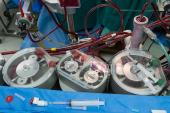ROOBY-FS: 10-Year Data Affirm On-Pump CABG as Default Strategy
The off-pump technique should be reserved for those with severe calcification and other high-risk scenarios, editorialists say.

Patients who undergo CABG surgery with an on-pump approach have longer revascularization-free survival over time compared with those undergoing an off-pump approach, according to final 10-year results from the Department of Veterans Affairs’ ROOBY-FS study.
While there was no difference in the individual endpoint of all-cause death between on- and off-pump patients, the time to the combined endpoint of all-cause death or subsequent revascularization with PCI or repeat surgery was about 4 months shorter with the off-pump strategy.
Senior study author A. Laurie Shroyer, PhD (Stony Brook University, NY), told TCTMD that, on the whole, the results “speak to the stability and durability of CABG for symptom relief.” Regardless of technique used, approximately 70% those who survived 10 years had sustained improvements in angina from baseline and 62% had sustained improvement in NYHA functional class.
The 10-year results from ROOBY-FS—an extension of the ROOBY trial begun in 2002—are the first longer-term data from a large RCT comparing the two CABG approaches. The 5-year data from ROOBY-FS suggested that off-pump CABG patients had significantly higher rates of mortality and MACE than those treated with the on-pump approach, calling into question the newer strategy that many hoped would allow for fewer cognitive side effects and faster recovery times.
In contrast, the 10-year data show comparable rates of all-cause death between the off-pump and on-pump groups (34.2% vs 31.1%; P = 0.12). Repeat revascularization or death combined occurred in 49.6% of the off-pump and 45.6% of the on-pump group (P = 0.06). Additionally, an analysis of the time to death after randomization to off- or on-pump surgery showed no differences (5.3 vs 5.7 years; P = 0.08).
In an editorial accompanying the study, Arnaldo Dimagli, MD (Cleveland Clinic, OH), and colleagues say the long-term results support on-pump CABG as the default revascularization strategy, noting that off-pump cases currently account for only about 15% of all CABG performed in North America. They caution, however, that patients included in the trial were “highly selected, low-risk patients comprising more than 99% men” and note that ROOBY “excluded higher-risk patients who might derive benefit from off-pump CABG, such as patients with severe ascending aortic calcification, cirrhosis, and/or advanced cerebrovascular disease.”
Shroyer said she did not disagree with that assessment. “I think [ROOBY-FS] tells us that in terms of off- and on-pump, this probably is not the definitive study, because it doesn't address many of those special populations,” she said.
Final 10-Year Results
The 10-year results of ROOBY-FS, published online February 16, 2022 in JAMA Surgery, and led by Jacquelyn A. Quin, MD (Veterans Affairs Boston Healthcare System, West Roxbury, MA), included 2,203 veterans (mean age 63 years; 99.5% men) undergoing CABG at 18 VA medical centers. Baseline characteristics were similar between those randomized to off-pump (n = 1,104) or on-pump (n = 1,099), with high rates of diabetes and hypertension in both groups.
The mean time to first composite event was 4.6 years in the off-pump group and 4.9 years in the on-pump group (P = 0.03). The median time to the composite endpoint was 4.6 years versus 5.0 years (P = 0.03), equating to a 4.3-month advantage for the on-pump group for the endpoint of freedom from death or repeat revascularization.
No differences between the off- and on-pump groups were seen for the secondary outcomes of any repeat revascularization (P = 0.39), post-CABG PCI (P = 0.66), and repeat CABG (P = 0.05). The median time to death was 5.6 years in the off-pump group and 6.1 years in the on-pump group. Sensitivity analyses of the primary and secondary endpoints for those who received the treatment to which they were randomized confirmed no differences at 10 years except for lower survival in the off-pump versus on-pump group (P = 0.03).
Among patients who developed new postoperative atrial fibrillation (AF), there were no significant differences between the on- and off-pump groups for AF at 10 years. Nor were there differences in the late AF rate among patients who did not have postoperative AF.
The ROOBY-FS researchers also conducted an analysis of 10-year postoperative costs, finding no significant differences at any time point.
Collaborative Work Planned
Prior to publication of the 5-year ROOBY-FS results, the CORONARY and GOPCABE trials had shown no difference in mortality or other outcomes between on- or off-pump CABG out to 5 years. The persistence of an advantage for on-pump out to 10 years in ROOBY-FS raises questions about why all these trials are not on the same page.
To TCTMD, Shroyer said she is set to begin a collaboration with the CORONARY and GOPCABE investigators to pool the data in hopes of gaining better insight.
“I think each of our major trials tells a piece of the story, but together, when we combine all three large data sets, particularly for some of the smaller at-risk subgroups, we may have a better story to tell,” she said. Shroyer added that a phase V dissemination study also is in the works, in collaboration with the Society of Thoracic Surgeons, to understand the impact of the on- and off-pump trials on practice patterns.
For their part, Dimagli and colleagues conclude that although definitive benefit from off-pump CABG for subsets of higher-risk patients remains unclear, it “should be used selectively for patients who may gain benefit from it and, ideally, performed by surgeons experienced and skilled in its use.”
L.A. McKeown is a Senior Medical Journalist for TCTMD, the Section Editor of CV Team Forum, and Senior Medical…
Read Full BioSources
Quin JA, Wagner TH, Hattler B, et al. Ten-year outcomes of off-pump vs on-pump coronary artery bypass grafting in the department of Veterans Affairs: a randomized clinical trial. JAMA Surg. 2022;Epub ahead of print.
Dimagli A, Weiss AJ, Bakaeen FG. Off-pump coronary artery bypass grafting— not for every patient, not for every surgeon. JAMA Surg. 2022;Epub ahead of print.
Disclosures
- Quin and Dimagli report no relevant conflicts of interest.
- Shroyer reports receiving a grant from the VA Cooperative Studies Program during the conduct of the study.





Comments